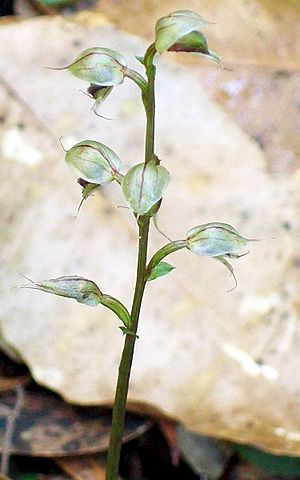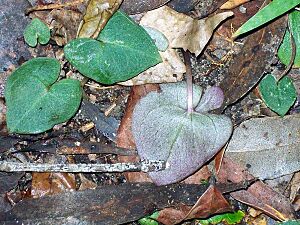Bristly mosquito orchid facts for kids
Quick facts for kids Pixie caps |
|
|---|---|
 |
|
| A. fornicatus at Chatswood West, Australia | |
| Scientific classification | |
| Genus: |
Acianthus
|
| Species: |
fornicatus
|
| Synonyms | |
|
|
Acianthus fornicatus, often called the pixie cap orchid, is a type of flowering plant. It belongs to the orchid family, Orchidaceae. This special plant grows only in New South Wales and Queensland in Australia. It's a plant that grows in the ground, not on other plants. It has one heart-shaped leaf and pretty, see-through pinkish-red flowers. You can find it in many places along the coast and nearby areas.
Contents
What Pixie Caps Look Like
The pixie cap orchid is a plant that grows from the ground. It lives for many years and loses its leaves in some seasons. It has a single, dark green leaf shaped like a heart. The bottom of the leaf is reddish-purple. This leaf is about 10 to 40 mm (0.4 to 1.6 in) long and 10 to 20 mm (0.4 to 0.8 in) wide. It sits on a stem that is about 4 to 9 cm (1.6 to 3.5 in) tall.
Each plant can have up to ten flowers. These flowers are spaced out along a tall stem, which can be 100 to 300 mm (3.9 to 11.8 in) high. Each flower is 10 to 40 mm (0.4 to 1.6 in) long and looks see-through, with a pinkish-red color. The central part of the flower, called the labellum, is green and sometimes looks almost black.
The top part of the flower, called the dorsal sepal, is shaped like an egg. It's about 9 to 12 mm (0.4 to 0.5 in) long and 5 to 6 mm (0.20 to 0.24 in) wide. It forms a little hood over the central part of the flower, which is called the column. The side sepals are also 9 to 12 mm (0.4 to 0.5 in) long and about 1.4 mm (0.06 in) wide. Their tips can be crossed or run side-by-side. The petals are small, about 4 mm (0.16 in) long and 1 mm (0.04 in) wide, and they spread out widely.
The labellum is green, but sometimes it's blackish. It's shaped like an egg or a spear, with its edges curled under. If you flatten it, it looks heart-shaped, about 5 to 6 mm (0.20 to 0.24 in) long and 2.5 to 3 mm (0.098 to 0.118 in) wide. It has a thick, fleshy area in the middle called a callus. The outer half of the labellum has many tiny bumps. Pixie cap orchids usually bloom between May and August.
You can tell this orchid apart from other similar types because its flowers are quite large and stick out. They are usually pinkish, and the dorsal sepal and labellum are wide.
How Pixie Caps Got Their Name
The pixie cap orchid, Acianthus fornicatus, was first officially described in 1810. A botanist named Robert Brown wrote about it in his book Prodromus florae Novae Hollandiae. The second part of its scientific name, fornicatus, comes from a Latin word. It means "vaulted" or "arched," which might describe the shape of its flowers.
Where Pixie Caps Live
This type of orchid is very common and can be found in many places along the coast and in areas close to the coast. It likes to grow in forests with lots of heath plants and in coastal scrubland. It prefers sandy soil that drains water well. You can find it in Queensland and in New South Wales, reaching as far south as Eden.
Protecting Pixie Caps
In New South Wales, the pixie cap orchid is not considered to be in danger. However, in Victoria, it is classified as a threatened species. In Victoria, you can only find it on Gabo Island.
See also
 In Spanish: Acianthus fornicatus para niños
In Spanish: Acianthus fornicatus para niños


